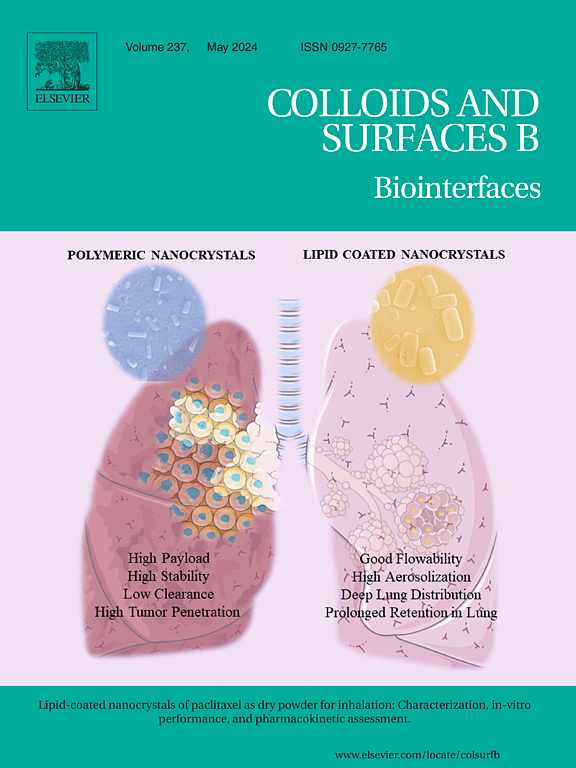Colloidal processing as a successful alternative to produce PLA/Mg composites with tailored mechanical and biodegradation properties
IF 5.6
2区 医学
Q1 BIOPHYSICS
引用次数: 0
Abstract
The PLA/Mg composite has been proposed as a promising new biodegradable biomaterial with interesting properties for use in a number of biomedical applications. However, its processing is still highly problematic mainly due to its high reactivity and biodegradability. Recently the benefit of a new processing route based on a colloidal approach has been proposed based on the particle surface modification with different polyelectrolytes. Colloidal route improves the mechanical and biodegradation properties as a consequence of the creation of a strong polymer-metal interface and an increase of the particle dispersion. In this paper, we demonstrated these benefits compared with the most widespread mixing technique, the thermal extrusion. Firstly, PLA/Mg composite was evaluated in terms of its thermal behavior to determine the processing parameters required. After processing, the colloidal composite presents a covalent bond between the metallic particle and thepolymer when produced by the process of reactive extrusion, as determined by FTIR-ATR. This results in an improvement of the dispersion and the mechanical properties, reaching a maximum compressive strength of 130 MPa and an elastic modulus of 2150 MPa with 25 vol.% Mg particle loading. The colloidal processing also interferes in the biodegradation properties of PLA/Mg, decreasing the H2 release by 35 %, increasing the degradation time, and producing materials that degrade more homogeneously. Furthermore, the colloidal composite was found to be cytocompatible as the tests carried out with the ST2 bone marrow stromal cell line showed no negative effects. The cells exhibited a three-dimensional spreading morphology on the materials.
胶体加工是生产PLA/Mg复合材料的成功选择,具有定制的机械和生物降解性能
PLA/Mg复合材料被认为是一种有前景的新型可生物降解生物材料,具有有趣的性能,可用于许多生物医学应用。然而,由于其高反应性和生物可降解性,其处理仍然存在很大问题。近年来,人们提出了一种基于胶体法的新工艺路线,该路线基于不同聚电解质对颗粒表面的改性。胶体路线改善机械和生物降解性能的结果是一个强大的聚合物-金属界面的创建和颗粒分散的增加。在本文中,我们展示了这些好处与最广泛的混合技术,热挤压。首先,对PLA/Mg复合材料的热性能进行了评价,确定了所需的工艺参数。经加工后的胶体复合材料在反应挤出过程中,金属颗粒与聚合物之间呈现共价键,由红外光谱- atr测定。这导致分散性和力学性能的改善,在25 vol时,最大抗压强度达到130 MPa,弹性模量达到2150 MPa。% Mg颗粒负载。胶体处理还干扰了PLA/Mg的生物降解性能,使H2释放量降低了35% %,增加了降解时间,并使材料的降解更加均匀。此外,胶体复合材料被发现具有细胞相容性,因为与ST2骨髓基质细胞系进行的试验显示没有负面影响。细胞在材料上呈三维铺展形态。
本文章由计算机程序翻译,如有差异,请以英文原文为准。
求助全文
约1分钟内获得全文
求助全文
来源期刊

Colloids and Surfaces B: Biointerfaces
生物-材料科学:生物材料
CiteScore
11.10
自引率
3.40%
发文量
730
审稿时长
42 days
期刊介绍:
Colloids and Surfaces B: Biointerfaces is an international journal devoted to fundamental and applied research on colloid and interfacial phenomena in relation to systems of biological origin, having particular relevance to the medical, pharmaceutical, biotechnological, food and cosmetic fields.
Submissions that: (1) deal solely with biological phenomena and do not describe the physico-chemical or colloid-chemical background and/or mechanism of the phenomena, and (2) deal solely with colloid/interfacial phenomena and do not have appropriate biological content or relevance, are outside the scope of the journal and will not be considered for publication.
The journal publishes regular research papers, reviews, short communications and invited perspective articles, called BioInterface Perspectives. The BioInterface Perspective provide researchers the opportunity to review their own work, as well as provide insight into the work of others that inspired and influenced the author. Regular articles should have a maximum total length of 6,000 words. In addition, a (combined) maximum of 8 normal-sized figures and/or tables is allowed (so for instance 3 tables and 5 figures). For multiple-panel figures each set of two panels equates to one figure. Short communications should not exceed half of the above. It is required to give on the article cover page a short statistical summary of the article listing the total number of words and tables/figures.
 求助内容:
求助内容: 应助结果提醒方式:
应助结果提醒方式:


